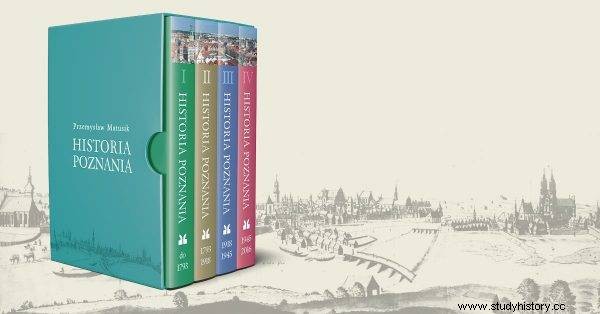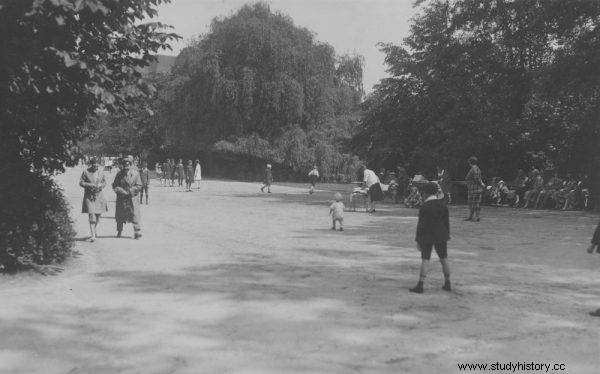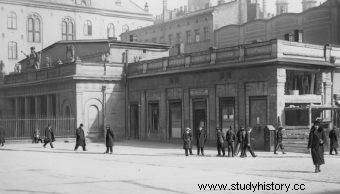Electricity and a bathroom in an apartment in the interwar period were synonymous with luxury for many Poles. But it wasn't like that everywhere. One Polish city in particular stood out in terms of modernity. For some people, coming here had the "taste of going abroad" - to the West.
In general - to recall Jerzy Waldorff's opinion again - "Poznań could delight newcomers, especially from other parts of the country". This opinion of a landowner's son is echoed by the memory of a young farm worker near Konin, who wrote years later, evoking an image of a truly Beniaminian flâneur:
I was enchanted by the life and traffic in the city, exhibitions, trams, dressed-up passersby who, according to my understanding, did not work anywhere, but only walked back and forth on the sidewalks.
Deceptively similar to… Berlin
Of course, you could always find malcontents, in 1928, the Krakow artist Ludwik Puget, who lived here at that time, wrote:
driving (...) through the streets of Berlin, I suddenly felt - ironically, horror! - like at home. (...) these houses, shops, signs ... I just had the impression that I was in Poznań! It seemed to me that at any moment a tram with the words "Śródka" or "Jeżyce" would appear around the corner (...). Hmm…! There is nothing to be deluded. Of course it is not Berlin that is so similar to Poznań, but Poznań to Berlin . O horror! This scandal must stop .

Poznań in the interwar period
To achieve this, Puget, otherwise known as Beautiful Lulu, therefore with his indolence, called for the towers of the imperial castle to be crowned with ... baroque helmets "of Polish character".
Greenery and flats with bathroom
And yet filling the Prussian form with predominant Polish content gave Poznań a special character, even the heavy shape of Prussian buildings, criticized not only by Puget, could not obscure the decisive advantages of the city.
Its great advantage was its civilization class, the effect of intensive Prussian investments in the pre-war quarter of a century, excellent urban infrastructure, gas, electricity, good pavements, trams , public buildings of the castle district, perfectly laid out modern neighborhoods. The possibility of getting an apartment with a bathroom was an important factor attracting intellectuals from other districts of the country to the city.

The text is an excerpt from the four-volume publication by Przemysław Matusik "Historia Poznania", which has just been published by the Posnania City Publishing House.
In the fall of 1924, a graduate student from Łódź, and in the future an outstanding actor Władysław Hańcza (then still Tosik), came to the town, to whom someone drew attention to Poznań - "a young university, a pleasant city". For him, coming here even had "the aftertaste of a trip abroad". As he wrote:
I remember coming to Poznan in the evening, around 6pm. (...) Despite the evening and unusual lighting, I started to like the city immediately. Little to like, I started to get involved, succumb to some mood that could not be described otherwise as "festive", clean, calm, pretty.
After the disgusting in its dirt and undeveloped Łódź of that time, its nervous mood, after the noisy, noisy Warsaw - Poznań made an impression on the newcomer with its cleanliness, greenery, peace, some balance and serenity .
"Warsaw was not the West, but Poznań was already"
It is also worth quoting the opinion of Czesław Miłosz from Vilnius, who, years later, stated:" The first time I actually felt the West when I was in Poznań at the national exhibition while still at school. Warsaw was not the West, but Poznań was already. ”
This statement is not surprising, considering that already in 1921 as many as 96.1% of houses were made of brick, while in Vilnius only 27% in Warsaw, 69.1% in Warsaw, and 85.5% in Kraków. . Moreover, in 1921, 2/3 of the flats had three or more rooms here, 10.9% were single-room flats, while in the whole of Poland, in cities with more than 100,000 inhabitants, this percentage was as high as 40.2%.

Poznań impressed the newcomer with its cleanliness, greenery, peace, some balance and serenity.
This also applied to the standard of flats, which was only ahead of Poznań from the larger cities in Katowice. In 1931, only 13.9% of Poznań buildings did not have any municipal installations, in Katowice - 3.6%, while in Warsaw - 24.6%, Kraków - 28.8%, Łódź - 31.3%, Lviv - 45 , 5% and Vilnius - 59.3%.
In the same year in Poznań 78% of buildings were equipped with a water supply, 68.2% with a sewage system, 63.5% with electricity and 56.3% with gas; Warsaw towered over the capital of Wielkopolska only in the degree of electrification, which amounted to 67.8% there, while in all other areas it fared worse, only 46.1% of the capital's flats had a sewage system, and 62% - a water supply.
Palm of priority
This image of the city - Western European in its shape and modern - was confirmed by other facts. Since the seizure of the airport in Ławica, Poznań has become within a few months the center of the best organized aviation in Poland, while the airport itself employed about 1,000 people.
From September 1, 1919, the first Polish aviation magazine "Polska Flota Napowietrzna" was published in Poznań, and on October 30, 1919, on the initiative of its editorial office , the first Polish sports aviation organization, Aero Club of Poland, was established at a meeting at the PTPN headquarters headed by the mayor of the city, Jarogniew Drwęski. In 1921, the first domestic air transport was launched, connecting Poznań with Warsaw and Gdańsk.

Wolności Square in Poznań
The people of Poznań did not lag behind in other areas as well, on April 24, 1927 at At 5.00 p.m., almost exactly a year after the regular radio station in Warsaw was launched, the Poznań radio station began broadcasting, which was listened to with enthusiasm by the crowds of thousands gathered on Plac Wolności. It was possible thanks to the efficient acquisition of local funds, for which a broadcasting station and a studio were built, located at Plac Wolności 11, in the Esplanada building (today Arkadia).
It was in Poznań that the broadcast of a football match and mass were broadcast for the first time in Poland, but the specialty of the local radio station became - as befits Poznań - music programs. One could multiply similar examples, the 1920s was the exuberant development of the Poznań film industry (...).
Pre-war multiplex
There were a dozen or so cinemas in the city, one of its biggest attractions was the biggest in Poland Słońce Cinema-Theater, opened on December 20, 1927 at Plac Wolności 6, owned by the merchant Stefan Kałamajski, with 1,600 seats, equipped with the most modern projection devices, air conditioning, its own power plant and lighting for 3,600 light bulbs, and by the time the sound film is released, it will also have its own 17-person orchestra.

I was captivated by the life and traffic in the city, exhibitions, trams, dressed-up passersby who, according to my understanding, did not work anywhere, but only walked the sidewalks back and forth.
Two months earlier, not far from where Lambert's hall and garden used to be, Jan Łuczak (with the help of Józef Czepczyński's funds) opened a real entertainment complex, a prototype of today's multiplexes, which included two cinemas:the monumental Metropolis with 1000 seats and not much smaller, already operating here Apollo . As the legend has it, in order to tease his competitor and brother-in-law Kałamajski, Łuczak ordered at the entrance to the cinema to hang a plaque with the words:"You have given me God in your generosity, give me also to the one who envies me".
Poznań's modernity was also expressed in a different way. As the author of the brochure published in the year of the General National Exhibition wrote:
3 times smaller than Łódź in terms of population, Poznań has 10 times more carriages than Łódź, leaving other cities of the same size far in this respect. It is enough to look through the daily newspaper to see from the car accident sections that our chauffeurs are no different from their colleagues, e.g. New York, invading guilty passers-by.
Source:
The text is an excerpt from the four-volume publication by Przemysław Matusik "Historia Poznania", which has just been published by the Posnania City Publishing House.
